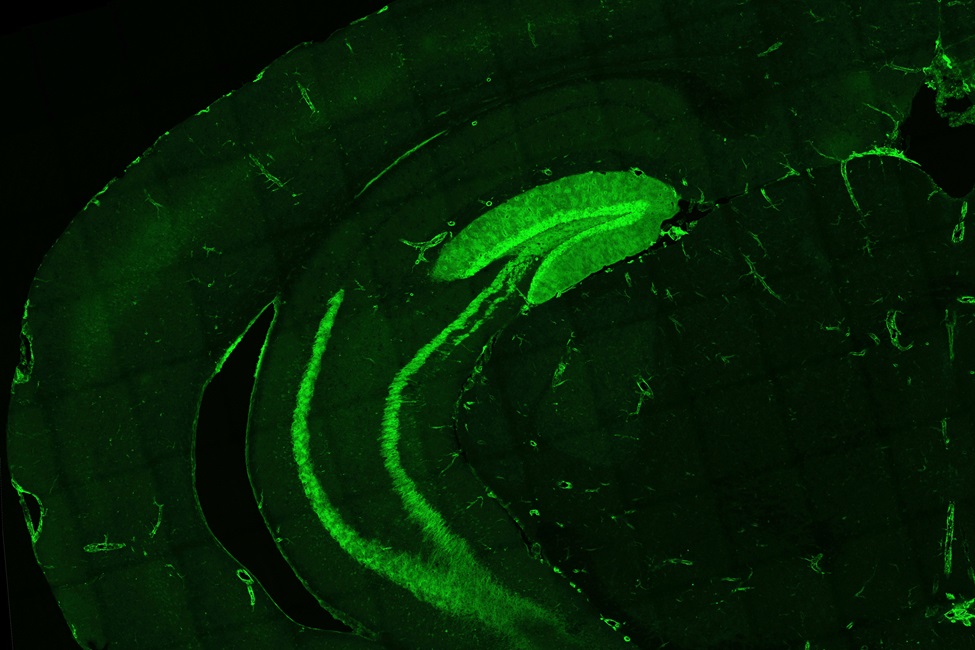'Ding-Dong:' A Study Finds Specific Neurons With an Immune Doorbell

IL-1R1 expression labeled in green within the hippocampus and somatosensory cortex.
Interleukin-1 (IL-1) is a key molecule involved in inflammation and plays an important role in both healthy and diseased states. In disease, high levels of IL-1 in the brain are linked to neuroinflammation, which can disrupt the body’s stress response, cause sickness-like behaviors, worsen inflammation by activating brain immune cells, and allow immune cells from the body to enter the brain. It also can lead to brain damage by causing support cells to produce harmful molecules. Elevated IL-1 levels are associated with mood disorders, such as depression, and problems with memory and thinking.
Conversely, in normal conditions without inflammation, IL-1 has essential roles in the brain. It helps regulate hormone activity, supports healthy sleep patterns, and improves cognitive functions such as memory and learning.
IL-1R1 is like a doorbell on cells that gets rung when there’s an infection or injury, and in immune cells, it signals the body to start an immune response. However, neurons that express IL-1R1 are not thought to induce inflammation, suggesting that these cells may actually integrate immune signals into neural ones. It has yet to be revealed where or how IL-1R1 (Interleukin-1 Receptor Type 1) may control or modify normal brain function.
Now, a new study by Florida Atlantic University provides the most detailed and comprehensive mapping of neuronal IL-1R1 (nIL-1R1) expression in the mouse brain to date, resolving long-standing inconsistencies. Previous research has suggested that IL-1 signaling in neurons is involved in sickness behaviors, anxiety, and changes in sleep, but the exact neural circuits involved have not been well-defined.
The study, published in the Journal of Neuroinflammation, narrows down the specific neuronal populations and neurotransmitter systems that could mediate these effects. Researchers were able to tag neuronal populations that express nIL-1R1 using a clever cell tagging approach, offering new insights into the functional roles of this receptor in the central nervous system (CNS).
Previous studies conducted by the FAU Quan Laboratory, reveal that chronic IL-1 signaling in glutamatergic neurons influences cognitive and social-avoidance behaviors, particularly in the context of neuroinflammation and stress-related disorders. This supports the idea that nIL-1R1 could play a crucial role in conditions such as chronic stress, depression and anxiety in the unique neural circuits described by the current study.
Using genetically modified mice, researchers identified neurons in certain brain areas such as the somatosensory cortex, hippocampus and others, which have neuronal IL-1R1. Most of these neurons use glutamate (a neurotransmitter for signaling), while some use serotonin (important for mood). They found that these IL-1R1-positive neurons are involved in circuits that control sensory processing, mood regulation and memory.
“Our study shows how certain neurons are connected to immune signals and may help explain how inflammation contributes to sensory, mood and memory disorders,” said Ning Quan, Ph.D., senior author, professor of biomedical science, FAU Schmidt College of Medicine, and an investigator in the FAU Stiles-Nicholson Brain Institute. “These findings could lead to new ways to treat brain disorders tied to inflammation. In terms of behavioral implications, our results support the hypothesis that nIL-1R1 signaling influences emotional and cognitive behavior.”
Results reveal that nIL-1R1 expression is most prominent in the somatosensory and glutamatergic systems, areas that had previously been understudied in this context. Among the brain regions identified as expressing nIL-1R1, the dentate gyrus (DG) was consistently highlighted, reaffirming its role as a key site for neuronal IL-1R1 expression. The study also pinpoints the thalamic relay centers and various sensory cortical regions, suggesting that IL-1 signaling could play a significant role in sensory processing.
“This new discovery opens up questions about whether immune signals influence our sensory processing and whether IL-1R1-mediated alterations of sensory signals contribute to cognitive issues, anxiety or depression,” said Dan Nemeth, Ph.D., first author and a postdoctoral fellow, FAU Schmidt College of Medicine and Stiles-Nicholson Brain Institute. “Furthermore, this study shows that neurons do not signal the same way other IL-1R1-expressing cells do.”
While researchers found neuronal IL-1R1 in brain regions related to mood, affect and cognition, an unexpected finding is that IL-1R1 is expressed in neurons in the sensory system. Using high-tech spatial transcriptomics, they identified that neuronal IL-1R1 regulates gene pathways involved in synapse organization without triggering typical inflammation. This suggests that IL-1R1 has a role in synaptic formation and can modify neural circuits and their function.
“With the most detailed mapping of neuronal IL-1R1 expression in the mouse brain to date, this study brings an unprecedented level of clarity to how IL-1 signaling impacts the neural circuits that govern behavior,” said Randy D. Blakely, Ph.D., co-author, executive director of the FAU Stiles-Nicholson Brain Institute, the David J.S. Nicholson Distinguished Professor in Neuroscience, and a professor of biomedical science in FAU’s Schmidt College of Medicine. “The findings open the door to new pathways of exploration, offering critical insights into the mechanisms underlying both normal and disrupted behavioral states seen in stress-related disorders, depression and anxiety.”
-FAU-
Latest Research
- FAU Researcher to Make Big 'Splash' in NatGeo's SharkFestShark fanatics, science buffs and ocean advocates won't want to miss a thrilling new episode of NatGeo's "Florida's Bite Capital," with FAU professor Stephen Kajiura, Ph.D. on National Geographic.
- FAU's Paulina DeVito Awarded Elite NSF Graduate Research FellowshipPaulina DeVito, 22, a Ph.D. candidate in FAU's College of Engineering and Computer Science, has been awarded a prestigious National Science Foundation fellowship for her exemplary work in AI and education.
- Hope for Brain Cancer: FAU Awarded Grants for Glioblastoma TreatmentFAU researchers are pioneering a new approach to treating glioblastoma - a highly aggressive brain cancer with one of the highest mortality rates - by targeting the gene MBLAC1 for the first time.
- Chef José Andrés' Longer Tables Fund Will Expand FAU Queen Conch LabThe grant awarded to FAU Harbor Branch supports the expansion of its queen conch aquaculture lab and is part of a global philanthropic effort to tackle urgent challenges through the power of food.
- FAU Gets $1M to Prevent Medication-related Harm, Falls in Older AdultsFAU Schmidt College of Medicine researchers will develop a targeted approach to eliminate the guesswork in medication management to reduce the risk of adverse drug events - particularly dangerous falls.
- Suicide Risk Elevated Among Young Adults with DisabilitiesSuicide is the third leading cause of death in young adults. For those with intellectual and developmental disabilities, the crisis is worse. New research urges prevention, screening and intervention reforms.






